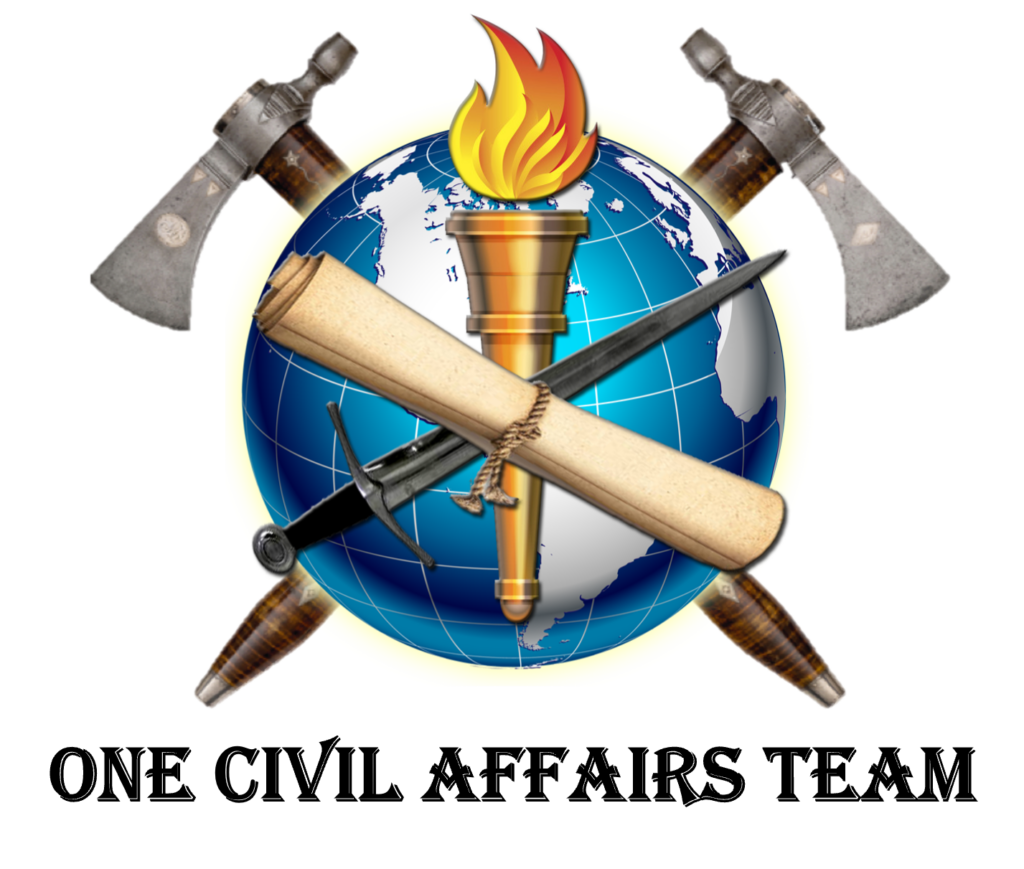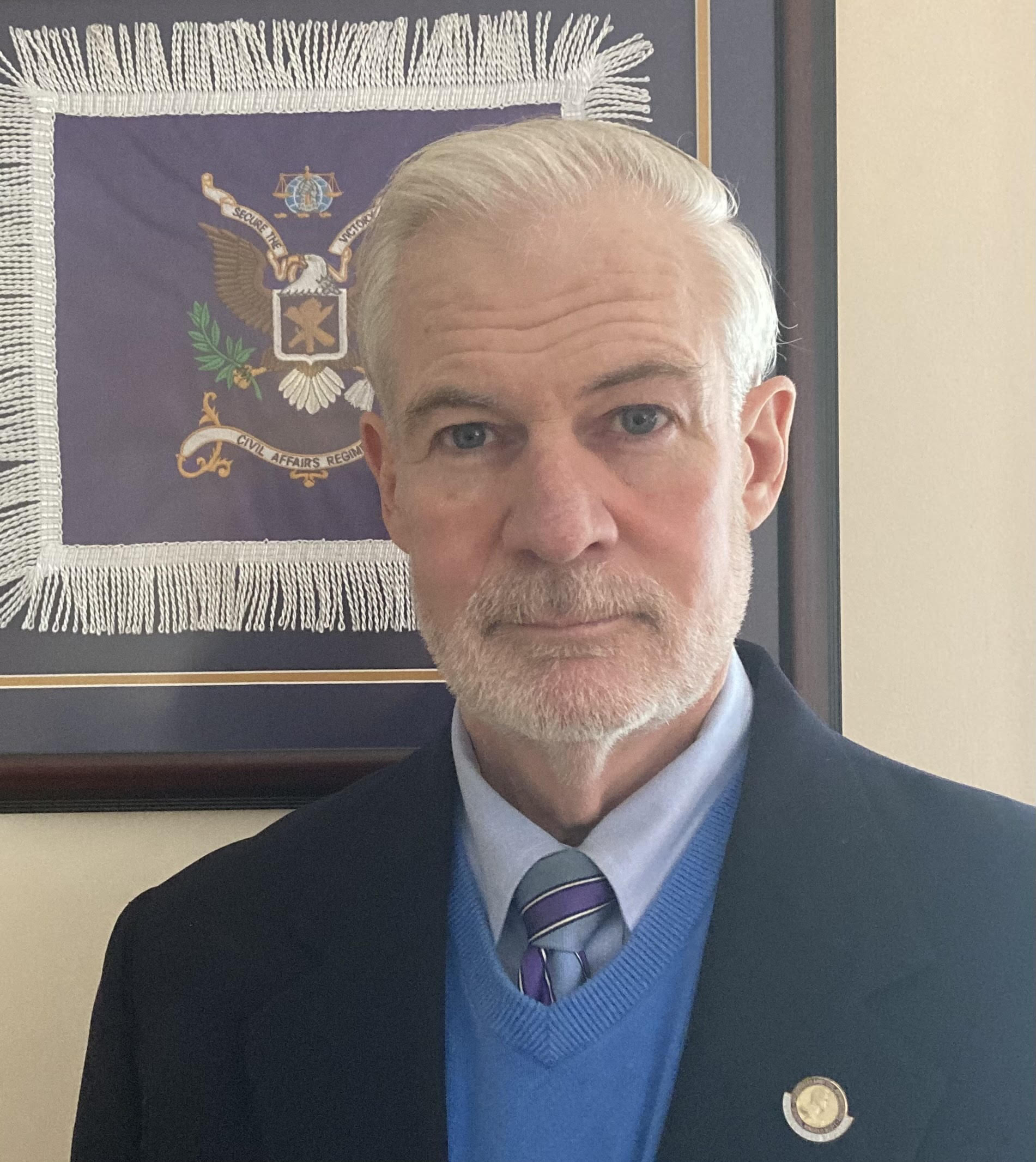7-minute read
I first heard of the idea to redesign the civil affairs branch insignia from the globe, torch, sword, and scroll described in CATR Post #10 to crossed pipehawks in 2015. Then-Majors Samuel L. Hayes, Jr., and Ken Nguyen presented the results of their Naval Postgraduate School capstone project, titled CA 2025: The Strategic Design of Civil Affairs, to key leaders of the civil affairs branch in the conference room of the old Army Special Operations Battle Lab (ARSOBL) on Schacknow Lane (formerly Mosby Street), where the parking lot for Chapman Hall is today. I was one year into my role as the Deputy Director of the Civil Affairs Force Modernization Directorate at the U.S. Army John F. Kennedy Special Warfare Center and School (USAJFKSWCS).
The Army had just published a new vision document outlining the qualities it needed to become the world’s premier land force by 2025. Sam and Ken recognized that, during the impending period of “retrenchment, resource constraints, and downsizing,” the Army’s civil affairs force needed to realign itself “to adapt…to the dynamic global security environment…and in so doing, demonstrate its own strategic relevance.” They used a process called Design Thinking to develop a “strategic redesign of the U.S. Army Civil Affairs (CA) Regiment (sic) in 2025 in support of the Army 2025 strategic vision.” The project “yielded innovative prototypes of CA identity, strategic messaging, branding, human resource management (e.g., recruitment, selection, training, and professionalization), and force structure.”
Among the problems Sam and Ken identified in the process were the lack of a common CA identity, poor strategic messaging, and poor strategic branding, all of which were related to the lack of consensus over the history and lineage of civil affairs. In their discussion of these problems, they made a compelling case for looking back in U.S. Army history beyond the post-WWI occupation of the Rhineland and beyond the military government of General Winfield Scott during the mid-1800s war with Mexico to the accomplishments of Indian Scout James Beckwourth and the Corps of Discovery under Captain Meriwether Lewis and Lieutenant William Clark earlier in the 19th century. After testing several prototypes with multiple groups, including the key leaders of the CA branch, Sam and Ken recommended extending CA history to Lewis and Clark. A gray beret, a new shoulder sleeve insignia, a new branch insignia, and a regimental crest featuring crossed peace pipe tomahawks (also known as pipehawks) were among several symbols proposed for use in the CA rebranding.
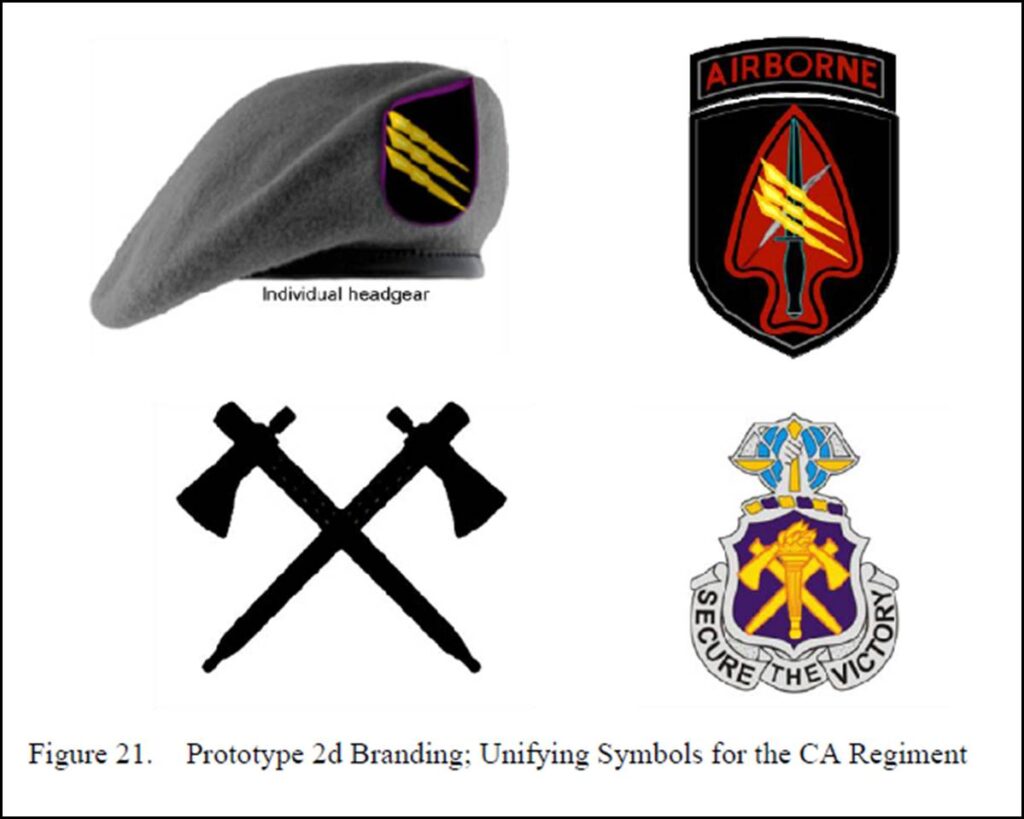
At that time, the CA branch did not seek to persuade the U.S. Army Center of Military History and the Institute of Heraldry that these changes were necessary for the civil affairs branch. However, the leadership of the 95th Civil Affairs Brigade (Special Operations)(Airborne) (95th CA Bde (SO)(A)) saw merit in implementing at least one of the recommendations for the special operations portion of the force “to distinguish the traditions and esprit de corps of Special Operations Forces Civil Affairs.” In 2019, the brigade command sergeant major, CSM Garric Banfield, submitted a packet to the commander of 1st Special Forces Command (Airborne) requesting authorization for “Civil Affairs (CMF 38) branch officers and NCOs assigned to the 1st Special Forces Command (Airborne) and subordinate organizations…to wear the pipe tomahawk (pipehawk) branch insignia in lieu of Civil Affairs Corps branch insignia” as an exception to DA Pam 670-1, paragraph 19-10b(14). That authorization was granted on 26 April 2019, as depicted in the image of the first signed memorandum for record below. Shortly thereafter, that authorization was extended to CA officers and NCOs assigned to the U.S. Army Special Operations Command and subordinate organizations, as depicted in the image of the second signed memorandum for record below.
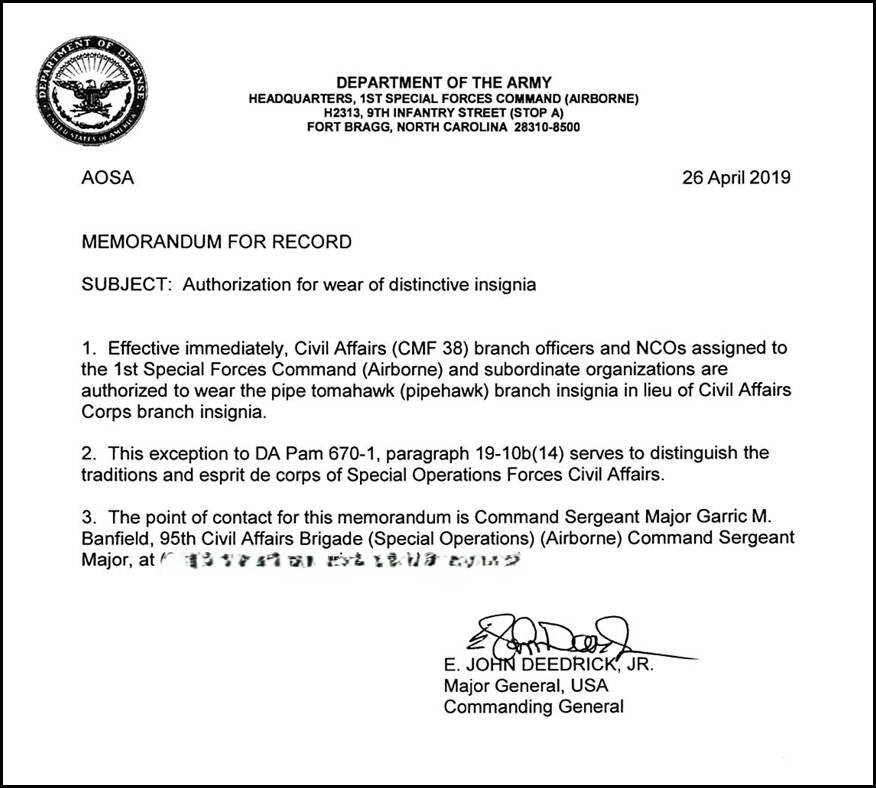
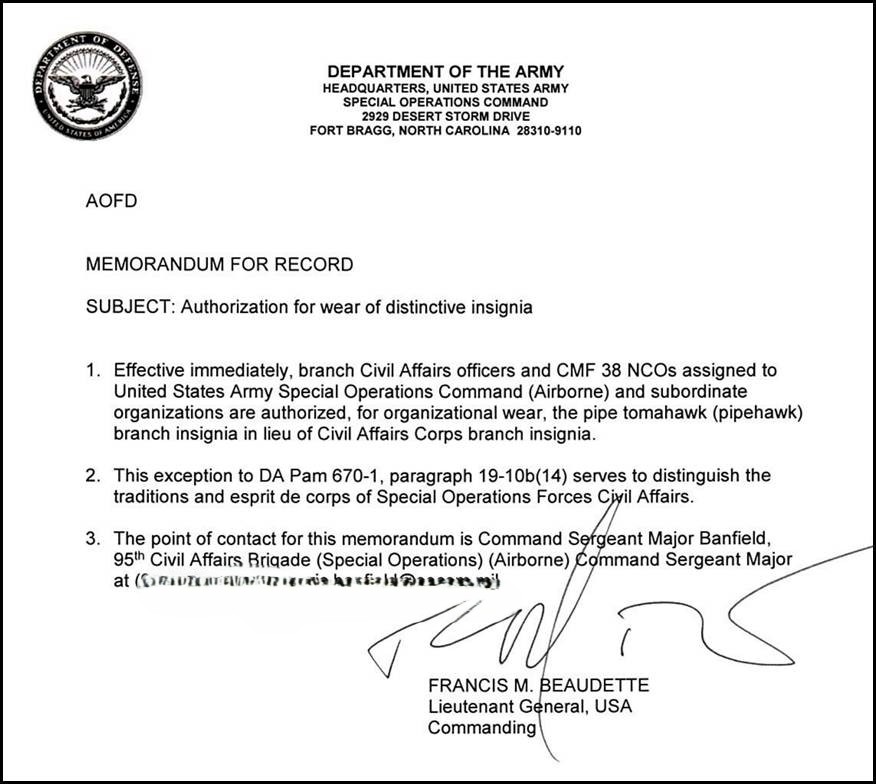
The only caveat, as mentioned in paragraph 1 of the USASOC memorandum, is that the pipehawks are authorized for organizational wear only. This means they can only be worn as long as the individual is assigned to a unit covered by the memorandum. Once a Soldier leaves that unit for a new assignment, he or she must revert to wearing the authorized Army CA branch insignia.
DA Pam 670-1 has been updated since these memoranda were signed. According to the current regulation, dated January 26, 2021, the relevant paragraph is now 21-10.c.(14), which describes the branch insignia authorized for wear by civil affairs officers and enlisted personnel – the globe, torch, sword, and scroll – which is also pictured in Figure 21-77 in the pamphlet.
It can be difficult for a Soldier to give up wearing a uniform item that is only authorized when assigned to a specific unit. Some might cite the cavalry collar insignia of two crossed sabers in scabbards that is currently authorized by DA Pam 67-1 for wear by “Officers and enlisted personnel assigned to cavalry regiments, cavalry squadrons, or separate cavalry troops…in lieu of the branch insignia when approved by the ACOM [Army command] commander.” Others might cite the maroon beret worn by paratroopers in scores of paid parachutist positions across many airborne formations, which are dwindling as we speak, following a recent Army resource decision. I, like many others who have spent more than one tour in the Army, have personal experience with wearing and then removing items worn as organizational wear.
My first experience was when I was assigned to the 4th Battalion, 9th Infantry Regiment (Manchu) in Alaska during Cadet Troop Leader Training in the summer of 1982. The unit wore an awesome brass belt buckle on the black web belt that held up the battle dress uniform trousers. It displayed the crest of the 9th Infantry Regiment, which featured an imperial five-toed dragon encircling a disc with the numeral 9 and the motto, “Keep Up The Fire.”
My second experience was when I was assigned to the 6th Battalion, 37th Field Artillery Regiment, in Uijongbu, Korea during my first tour in the Army. The unit’s awards and decorations included the Belgian Fourragere, earned in 1940, the Presidential Unit Citation, and the Republic of Korea Presidential Unit Citation, earned during the Korean War. I had to remove those items when I PCS’d to my next assignment.
My final experience was when I left my assignment to the 1st Battalion, 75th Ranger Regiment. For two years, I proudly wore a black beret with the 1st Battalion flash and had a Ranger tab on my patrol cap above my rank insignia. Once I left the unit and returned to “leg land” in Oklahoma and later Germany, I was no longer authorized to wear those symbols of excellence with my uniform. However, four years later, when I was assigned to USAJFKSWCS, a subordinate unit to USASOC, my boss informed me that, based on a USASOC policy letter similar to the second one above, I was authorized to wear my black beret once again.
Getting back to the pipehawks, the photo below depicts a plaque featuring actual pipehawks crossed in the manner of the SOF CA insignia, mounted on a wall in Munske Hall, the headquarters building of the 95th CA Bde (SO)(A). Below it is a scroll bearing the following inscription, drawn in part from the work of MAJs Hayes and Nguyen.
“The symbol of the pipehawk embodies the spirit of Civil Affairs going back to the Corps of Discovery established in 1803 by President Thomas Jefferson. The Corps of Discovery, while not officially a Civil Affairs unit, conducted what we would refer to today as Civil Reconnaissance and Civil Engagement during the expansion westward. President Jefferson recognized that the Army could embody the authority of governance in a way that civilians couldn’t, but also required uniquely qualified individuals.
The pipehawk symbolizes a choice between war and peace; it represents the ability to shape and build the environment through its use as a tool. The sharpened edge represents the ability to degrade and exploit through its use as a weapon, and the pipe bowl represents the ability to promote diplomacy or peace when objectives have been reached.”

Question for our teammates: Do you have any origin stories about how you changed or created institutional traditions somewhere that you’d like to share?
Send a note to the Civil Affairs Team Room.
Subscribe for updates to the Civil Affairs Team Room Blog
Don’t forget to check out our affiliated sites
LC38 Brand
Aerial Resupply Coffee
